ISSN ONLINE(2320-9801) PRINT (2320-9798)
ISSN ONLINE(2320-9801) PRINT (2320-9798)
P.S.Shibu1, K.Ramudu2
|
| Related article at Pubmed, Scholar Google |
Visit for more related articles at International Journal of Innovative Research in Computer and Communication Engineering
The main challenge of MIMO wireless communication system lies in the efficient implementation of detector. Spatial multiplexing is utilized in MIMO system to provide high transmission rate without allocating bandwidth and increasing transmitting power, which needs to separate the spatially multiplexed data stream at receiver. This paper presents a comprehensive study of the Bit Error Rate (BER) performance of 2-by-2 spatially multiplexed MIMO system incorporates with transmit diversity such as Space Time Block Code (STBC) and Space Frequency Block Code (SFBC) and signal detection techniques such as Zero Forcing (ZF), Minimum Mean Square error (MMSE) and Q-less QR decomposition under BPSK, QPSK, 16QAM and 64QAM digital modulation schemes. Bit error rate simulations shows that the Q-less QR decomposition based signal detection scheme results good performance over ZF and MMSE signal detection scheme.
KEYWORDS |
| MIMO, QR decomposition, ZF, MMSE, SFBC, STBC |
I. INTRODUCTION |
| MIMO technology can greatly enhance the capacity of wireless cellular networks and reliability of data transmission through wireless media. The use of multiple antennas at both ends of wireless link often referred as Multiple Input Multiple Output (MIMO) wireless communication system. It has been employed in fourth generation (4G) wireless cellular standard such as 3rd Generation Partnership Project (3GPP) Long Term Evolution (LTE/LTE-Advanced), Worldwide Interoperability for Microwave Access (WiMAX) and high speed wireless LAN standard. The MIMO technique doesn’t require any bandwidth expansion or any extra transmission power. Therefore, it provides a promising means to increase the spectral efficiency of a system. Huge throughput gain can achieved through MIMO system. |
| Wireless signals propagate from the transmitter to the receiver through the radio channel. The radio channel has various inevitable sources of noise and fading. The received signal is distorted and errors will occur while detection at the receiver. In MIMO channel, each receiver antenna receives super imposed copies of the transmitted signal. In order to recover transmitted data from the received signal with lower bit error rate, researchers had already investigated many ways to improve the performance of MIMO detector. MIMO detector employs maximum likelihood principle to recover the transmitted data. Many MIMO detection algorithms have been proposed that can approach the statistically optimal performance of maximum likelihood detection. Due to the high complexity of these algorithms has made them unsuitable for widespread adoption in practical MIMO receiver designs. To fully exploit the potential of MIMO it is crucial to devise and employ a high fidelity and low complexity detection scheme at receiver end. |
II. MATHEMATICAL MODEL |
| In general MIMO techniques are grouped into two main categories namely; MIMO diversity technique and MIMO spatial multiplexing techniques. MIMO diversity can provide higher signal to noise ratio which improves transmission reliability. In MIMO diversity the same data stream is transmitted from multiple antennas or received at more than one antenna, which improves the diversity gain. MIMO spatial multiplexing can provide a linear improvement in the channel capacity without requiring additional spectral resources. |
| 1. Transmit diversity: |
| The transmit diversity improves the signal quality and achieves a higher signal to noise ratio at receiver side. Transmit diversity can effectively mitigate the multipath fading effects. Each antenna will experience a different interference environment and if one antenna experience a deep fade, then it is likely that another has sufficient signal. Transmit diversity can help improve the reliability of data reception and decoding as well. |
| In Space Time Block Code (STBC) modulated symbols are mapped into time and spatial domain, while in Space Frequency Block code (SFBC) symbols are mapped into frequency and spatial domain. |
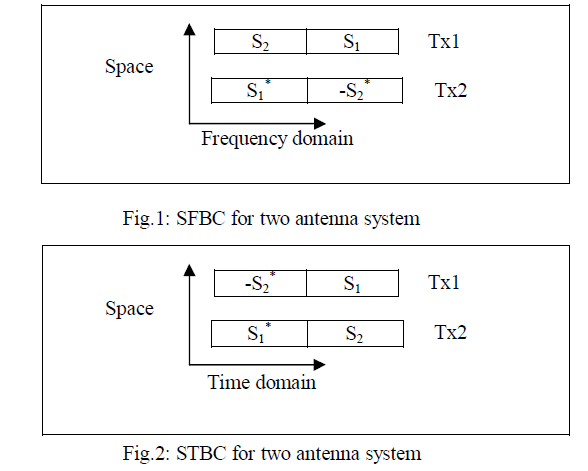 |
| 2. Signal detection schemes: |
| The linear signal detection scheme treats all transmitted signals as interferences except for the desired stream from the target transmitting antenna. The idea behind linear detection technique is to linearly filter received signals using filter matrices. This category includes Zero-Forcing and Minimum Mean Square Error (MMSE) techniques. Although linear detection schemes are easy to implement, they lead to high degradation in the achieved order and error performance due to the linear filtering. Let the spatially multiplexed transmitted user data be x = [x1, x2]T and received data be y = [y1, y2]T. Let n = [n1, n2]T be the noise factor and H be the channel matrix. The received signal y for 2-by-2 MIMO system can be represented as |
 |
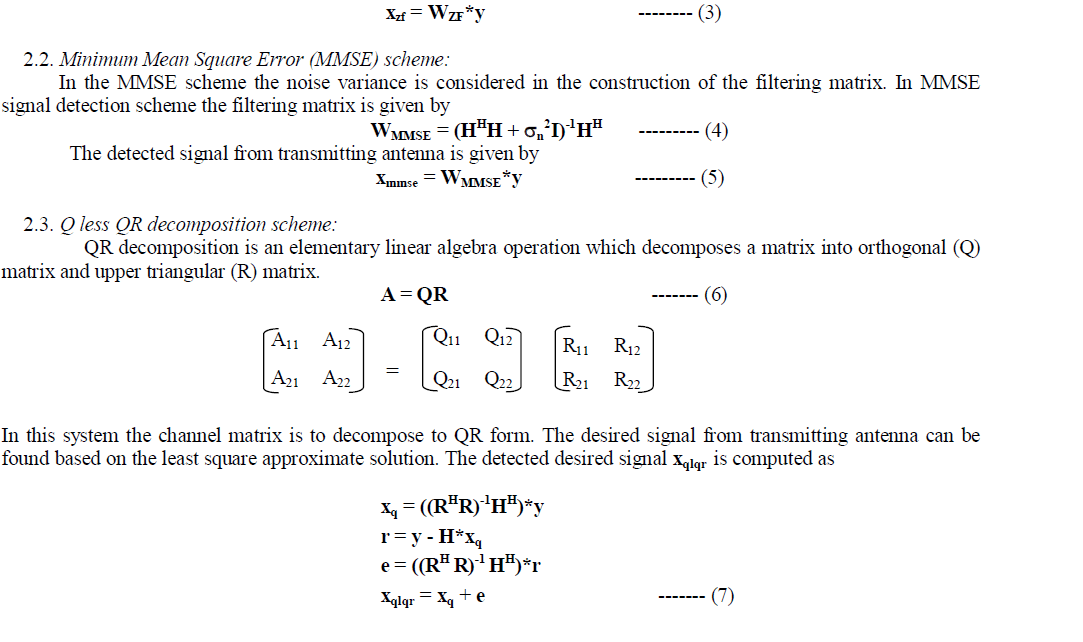 |
III. SYSTEM MODEL |
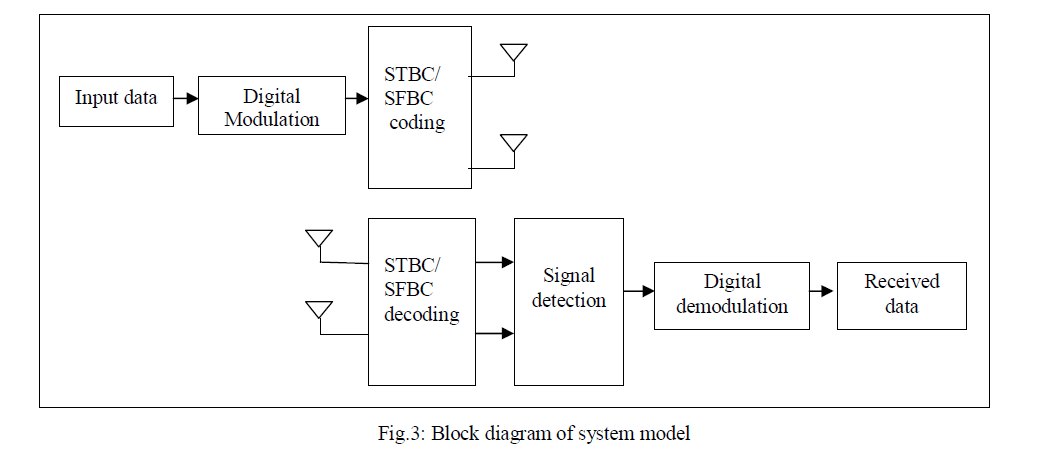 |
| The input data stream is digitally modulated using Binary Phase Shift Keying (BPSK), Quadrature Phase Shift Keying (QPSK), 16 & 64 Quadrature Amplitude Modulation (QAM). The digitally modulated symbols are then applied to the diversity coding and then transmitted. The received signal is to be processed with diversity decoding and perform the signal detection technique and processed for the digital demodulation to retrieve the transmitted data. |
IV. SIMULATION |
| The BER performance of 2-by-2 spatially multiplexed MIMO system with transmit diversity and signal detection scheme such as Zero-Forcing, Minimum Mean Square Error and Q less QR decomposition under digital modulation has performed using MATLAB software. The simulations are represented in terms of Signal to Noise Ratio (SNR) and Bit Error Rate (BER). |
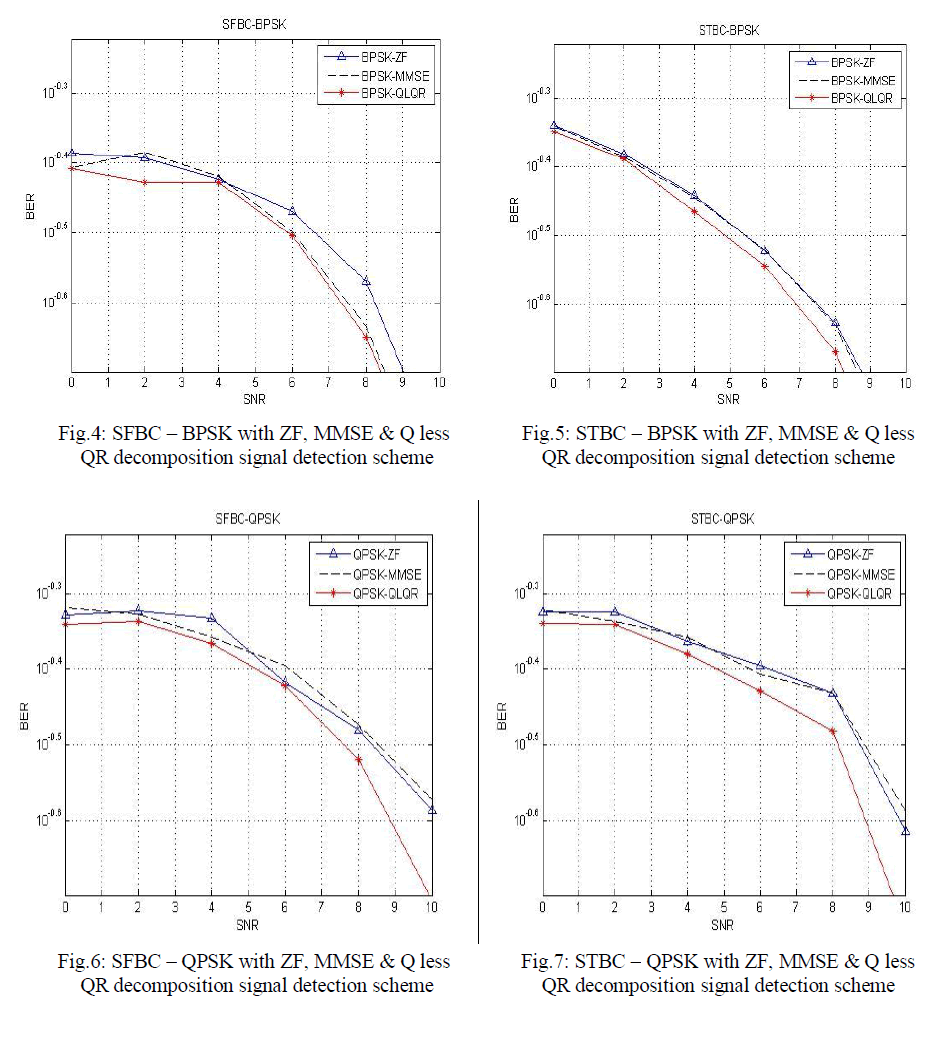 |
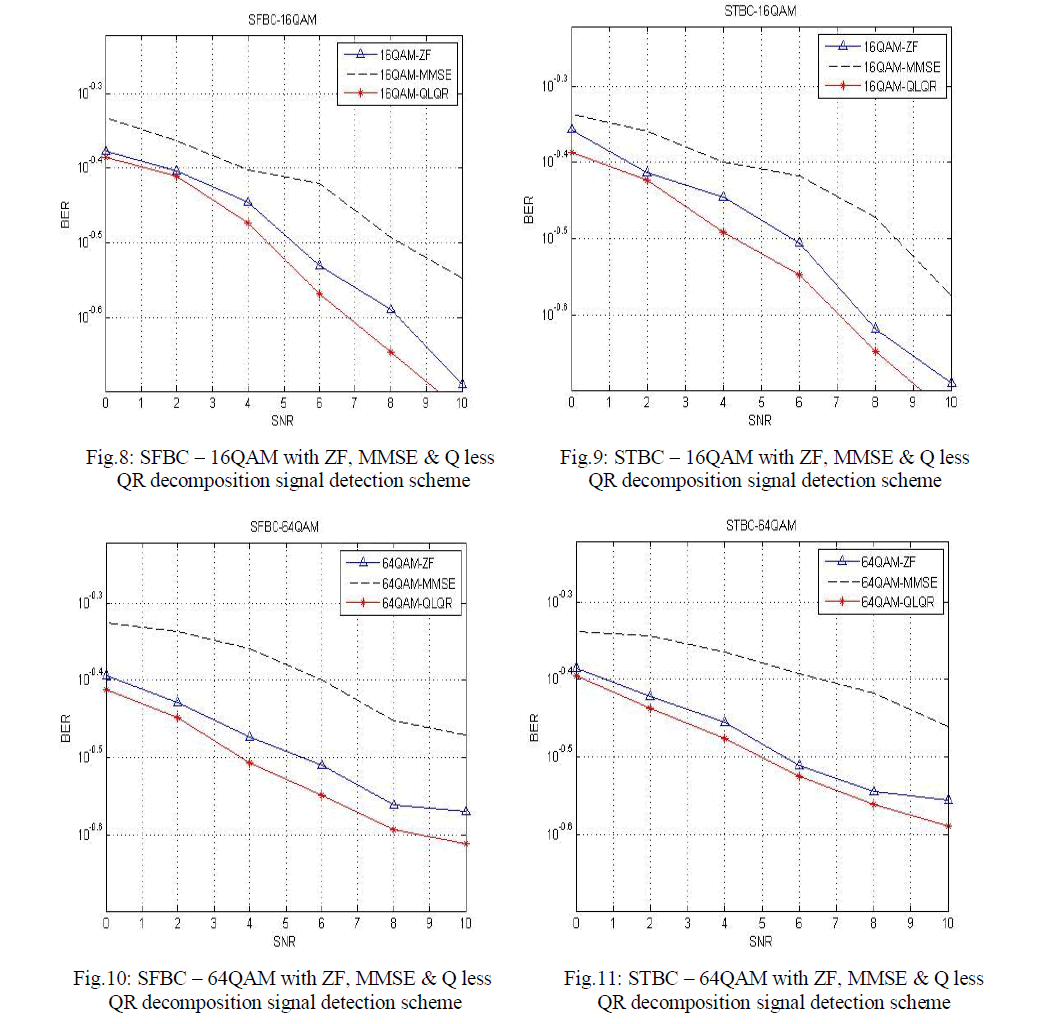 |
V. CONCLUSION |
| The simulation results for a 2-by-2 spatially multiplexed MIMO system incorporated with time diversity such as space frequency block code and space time block code over signal detection such as ZF, MMSE and Q less QR decomposition under different digital modulation is presented. It can be observed that the implementation of space frequency block coded QAM digital modulation with Q less QR decomposition based signal detection provides the good performance. |
References |
|